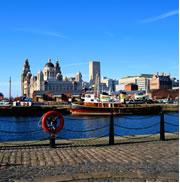 The ancient ports of Tyre and Sidon were to the ancient world as Liverpool has been in later times.© Getty
The ancient ports of Tyre and Sidon were to the ancient world as Liverpool has been in later times.© GettyThanks to political tensions easing in Lebanon, archaeologists have finally managed to locate the sites of ancient Phoenician harbours in the seaports that dominated Mediterranean trade thousands of years ago.
By drilling out cores of sediment from the modern urban centres of these cities, geologists have mapped out the former coastlines that the sediments have long since buried. From this they have pinpointed the likely sites of the old harbours, and have marked out locations that, they say, are in dire need of exploration and conservation.
The modern cities of Tyre and Sidon on the Lebanese coast were once the major launching points of the seafaring Phoenicians. They were to the ancient world what Venice, Shanghai, Liverpool and New York have been in later times: some of the greatest of the world's ports, and crucial conduits for trade and cultural exchange. From the harbours of the Phoenician cities, ships carried precious dyes and textiles, soda and glass throughout the Mediterranean and beyond.
“If urbanization isn't correctly regulated, many important archaeological sites will be damaged or lost.”
Nick Marriner
CEREGE, Aix-en-Provence, France
Both cities still carry the same name, but the coastlines on which they sit have been reshaped by silting since the time of the Phoenicians, about 3,000 years ago. Sidon has extended out to sea through the build-up of silt. And Tyre, which was once an island, has been joined up to the mainland by silting, while much of the old land has sunk beneath the waves.
But whereas these major geographical changes were roughly known, no one knew the exact shape of the old coastline, which would in turn reveal the positions of the ancient harbours themselves.
Digging in
Nick Marriner of the European Centre for Research and Teaching on the Geosciences of the Environment (CEREGE) in Aix-en-Provence, France, and his colleagues set out to drill beneath the modern city centres to determine how the coastlines have changed over time1-3.
Marriner explains that the political situation in Lebanon, with a civil war that only ended in 1990, has hindered attempts to explore its ancient history. Much of what is known about the Phoenician cities comes from indirect or old sources. "At Tyre, there are presently no large-scale excavation sites, and much of our knowledge derives from work undertaken during the nineteenth century through to the early 1970s," Marriner says.
Some of that early archaeological work has been challenged on further scrutiny. In the 1930s, for example, the French archaeologist and pioneer of aerial photography Antoine Poidebard claimed to have found the location of the southern harbour of ancient Tyre, which is now submerged. But recent work suggests that he instead found an urban part of the old city, rather than a port4.
To get a clearer picture, Marriner and his colleagues drilled a total of 40 cores throughout the two cities, and used radiocarbon dating of seeds, wood, charcoal and marine mollusc shells to determine the age of each layer.
The results shed some light on what is known of the cities. Both of the Lebanese sites were occupied since at least the Bronze Age (around 3,000 years BC). Tyre was conquered in 332 years BC by Alexander the Great. And both sites were later occupied by the Romans, then the Arabs and the Mameluke Turks.
Marriner's examination of the soil shows that the rate of coastal silting shot up tenfold during the Roman occupation. Their geological records show that the Romans and subsequently the Byzantines must have been forced to dredge the harbours to keep them workable. Trade during this period is known to have declined sharply.
Save and protect
ADVERTISEMENT
Most importantly, the work indicates where the old harbours lay: underneath today's urban centres.
Marriner hopes that his findings will help efforts to protect the cultural heritage of the two cities, and says that the Directorate General of Antiquities of Lebanon is very interested in the results. "They are rich historical and archaeological archives, and the real test is protecting them from the pressures of urban development," he says.
Both Tyre and Sidon are undergoing rapid, uncontrolled urban expansion. "There are plans to develop areas of Tyre as a tourist resort," says Marriner. "If this is not correctly regulated many important archaeological sites will be damaged or lost."
CEREGE, Aix-en-Provence, France
